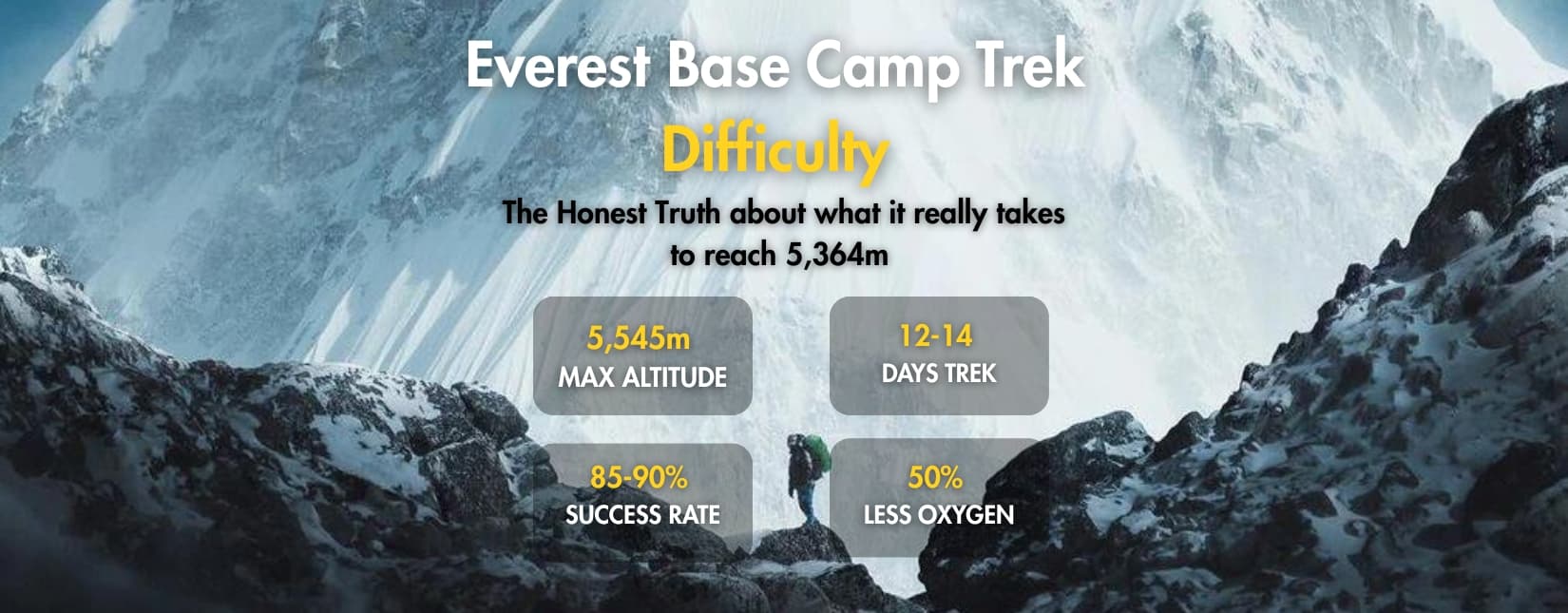Everest Base Camp Trek Difficulty: An Honest Look at its Reality
Being at the base of Mount Everest, the tallest mountain on earth, is a dream that is shared by so many trekkers that they literally number in thousands annually. The journey to the base camp of Everest has thus, been turned into a kind of a challenge that is most popular among outdoor enthusiasts in Nepal and hence, it is a very diverse group that consists of novices, and expert mountaineers who also happen to be climbers. But a single question is there in a potential trekker's mind, and that is:How difficult is the trek to Everest Base Camp really?
If you are thinking of setting out on this epic trek, getting a grip on what the challenge really is, would be necessary. The intention here isn't to frighten you off, but to equip you in such a way that when you reach 5,364 meters you will be able to take pride in your feet and even know what it was that you overcame.
Understanding EBC Trek Difficulty: The Real Picture

Let's get the truth out of the way first: The Everest Base Camp Trek is a moderate to challenging one. You are not going to the summit of Everest, no need for technical climbing skills, ropes, or ice axes. Still, it would be a reckless move to call it "just a walk" and to underestimate the trek by a great margin.
The trek is around 12-14 days long and the daily walking is about 5-7 hours on different types of ground. You will be going up a considerable amount of elevation, stay in places where the air will have about half the oxygen of that at sea level, and do things with your body that will probably astonish you.
The thing that sets this trek out is that it is not just one difficult factor. What makes it challenging is the combination of altitude, duration, terrain, and weather. Put it this way, the trek is more a challenge of stamina than one of technical skills.
The Altitude Factor: Your Biggest Challenge
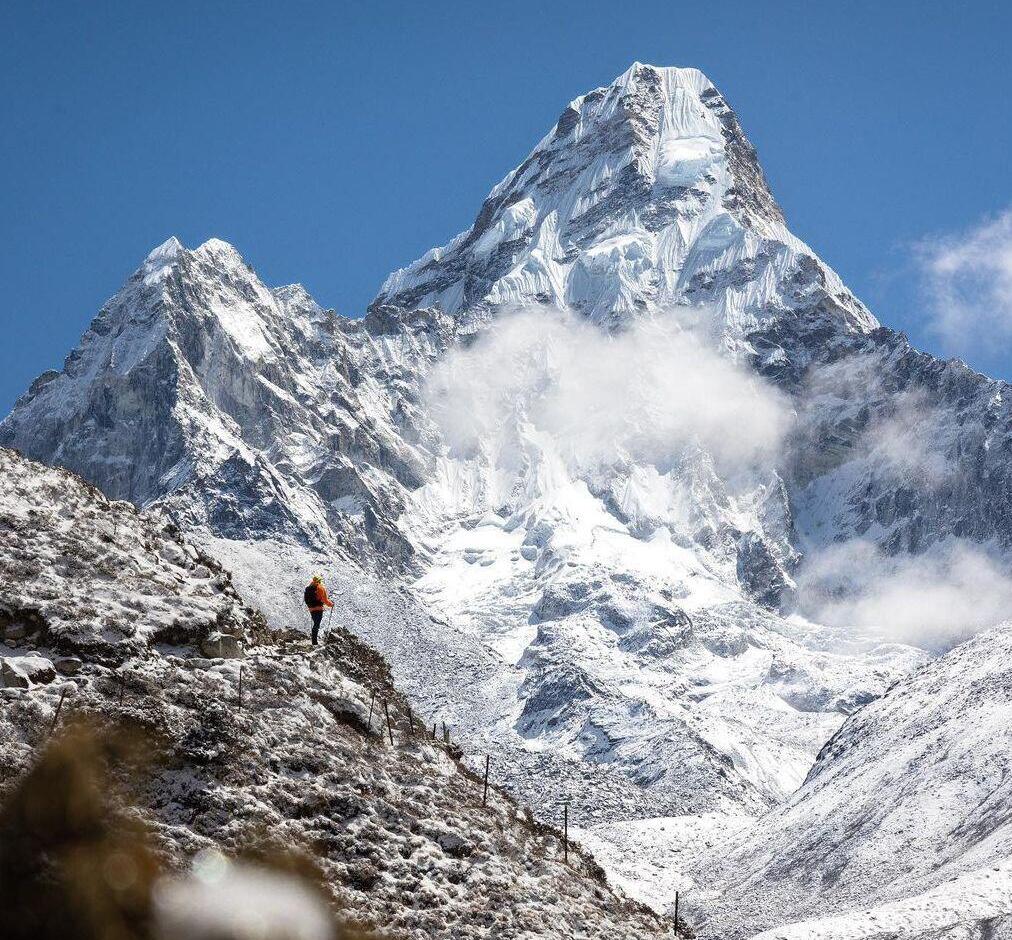
Altitude without a doubt is the major factor that makes the Everest Base Camp trek so hard. How about we get it straight, what this really forestalls your body to do, this mountainous altitude?
How Altitude Affects You
Atmospheric pressure is dropping with increasing height meaning that there is less oxygen in each breath you make. At Namche Bazaar (3440m), you are already at such an altitude where quite a few people start to feel the effects. When you get to Everest Base Camp at 5,364m, the oxygen level is about 50% of that at sea level.
Several parts of your body react to the different parts of the reduction in the following manner:
- To transport more oxygenated blood your heart rate gets elevated
- Your breathing speed goes up, and it is often accompanied with a feeling of heaviness although if you get a headache, it will be in the first few days that you spend above 3,000m
- The trekkers often say that they have a bad night's sleep while they are on the trail
- It is possible that your appetite will be reduced horribly
The Reality of Altitude Sickness
Indisputably, Acute Mountain Sickness (AMS) is a major concern, and a facade of incapacity only prolongs the suffering. The signs generally ensue are headaches, vomiting, dizziness, and weariness. It is common for trekking groups to encounter symptoms of the disease at least lightly during their expeditions.
Altitude Skicness Recognition and Response Guide
Altitude Sickness: Symptoms, Severity, and Actions
| Severity Level | Symptoms | What it Feels Like | Altitude Range | Immediate Action | Can Continue Trek |
|---|---|---|---|---|---|
| Mild AMS (Acute Mountain Sickness) | Headache, slight nausea, fatigue, dizziness, difficulty sleeping | Like a hangover or mild flu | Usually 2,500m+ | Rest, hydrate (3–4L water), eat light, take mild pain relief | ✅ Yes, with monitoring |
| Moderate AMS | Severe headache not relieved by medication, vomiting, increased fatigue, shortness of breath at rest | Significant discomfort, struggling to function normally | Usually 3,500m+ | Stop ascending immediately, rest 24–48 hours, consider descent | ⚠️ No, wait or descend |
| Severe AMS (HACE) | Confusion, difficulty walking (ataxia), extreme fatigue, irrational behaviour | Cannot walk straight line, mental confusion, very concerning | Usually 4,000m+ | Emergency descent required, administer dexamethasone, seek medical help | ❌ Descend immediately |
| HAPE (High Altitude Pulmonary Edema) | Extreme breathlessness at rest, cough with pink frothy sputum, chest tightness, blue lips | Feels like drowning, cannot catch breath even when resting | Usually 4,000m+ | Life-threatening emergency — immediate descent, give oxygen if available, seek evacuation | ❌ Evacuate immediately |
| Prevention | N/A | N/A | All altitudes | Climb slowly, hydrate constantly, "climb high – sleep low", listen to your body | ✅ Best approach |
Critical Rule: Never ascend with worsening symptoms. Descent is the only cure for altitude sickness.
What is the positive aspect of the situation? A correct acclimatization can totally save you from such an occurrence. This is also the reason why Namche Bazaar and Dingboche are so frequently featured in the itineraries with rest days planned for them. It is not that these days are left idle, as it is rather the opposite; these days are of absolute necessity for a trek done successfully. During the rest days, you are going to perform shorter hikes to a higher altitude but eventually come back for your bed, which is at a lower level, thus adhering to the principle that "climb high, sleep low".
The secret of how to deal with altitude comes down to three:
- Ascend gradually: Don't ever riot the ascent; allowing for extra days is worth it
- Stay hydrated: Try to drink up to 4 Liters of water each day
- Listen to your body: If the situation gets worse, descending is always the right thing to do
Physical Demands: What Your Body Will Go Through

Besides altitude, the physically demanding nature of the trek presents considerable challenges. To help you understand exactly what lies ahead, here's a detailed breakdown of the entire journey.
Complete Day by Day Trek Overview
Knowing the increase in challenge during your hike allows you to regulate your mind and body strength. This is the reality of each day:
| Day | Route | Distance(km) | Walking Hours | Starting Altitude | Ending Altitude | Difficulty Level |
| 1 | Lukla to Phakding | 8 km | 3-4 hrs | 2,860m | 2,610m |
Easy |
| 2 | Phakding to Namche Bazar | 10 km | 5-6 hrs | 2,610m | 3,440m | Moderate |
| 3 | Acclimatization Day - Namche | 5 km | 3-4 hrs | 3,440m | 3,440m | Easy |
| 4 | Namche to Tengboche | 10 km | 5-6 hrs | 3,440m | 3,860m | Moderate |
| 5 | Tengboche to Dingboche | 9 km | 5-6 hrs | 3,860m | 4,410m | Moderate |
| 6 | Acclimatization Day - Dingboche | 4 km | 3-4 hrs | 4,410m | 4,410m | Moderate |
| 7 | Dingboche to Lobuche | 8 km | 5-6 hrs | 4,410m | 4,940m | Challenging |
| 8 | Locuche to Gorak Shep to EBC | 13 km | 7-8 hrs | 4,940m | 5,364m | Challenging |
| 9 | Goark Shep to Kala Patthar to Pheriche | 16 km | 8-9 hrs | 5,164m |
5,545m (KP) |
Very Challenging |
| 10-12 | Return Trek to Lukla | varies | 5-7 hrs/day | Descending | 2,860m | Moderate |
Important Note:
- Day 2 to Namche Bazaar marks your first significant altitude gain and often catches people off guard
- Day 9 combining Kala Patthar and descent is consistently rated the most demanding day
- Acclimatization days are crucial, they're working days, not rest days
- The return journey is faster but still requires 2-3 days of solid walking
Daily Distance and Duration
The total distance covered on the trek is just under 130 km (approximately 80 miles). Two weeks may not be that long a time to divide the distance and think the daily hike isn't too much, but one should not forget that this is to be done in thin air, steep slopes and with a shoulder bag on.
On most days, the walking is about 5-7 hours, and only once or twice the work of the day extends to 8-9 hours, particularly if we consider the time for travel to Everest Base Camp and the vertical climb of Kala Patthar. The surface changes radically, from stone stairs carved through Sherpa villages to the moraine of glaciers that is full of boulders.
The Terrain Challenge
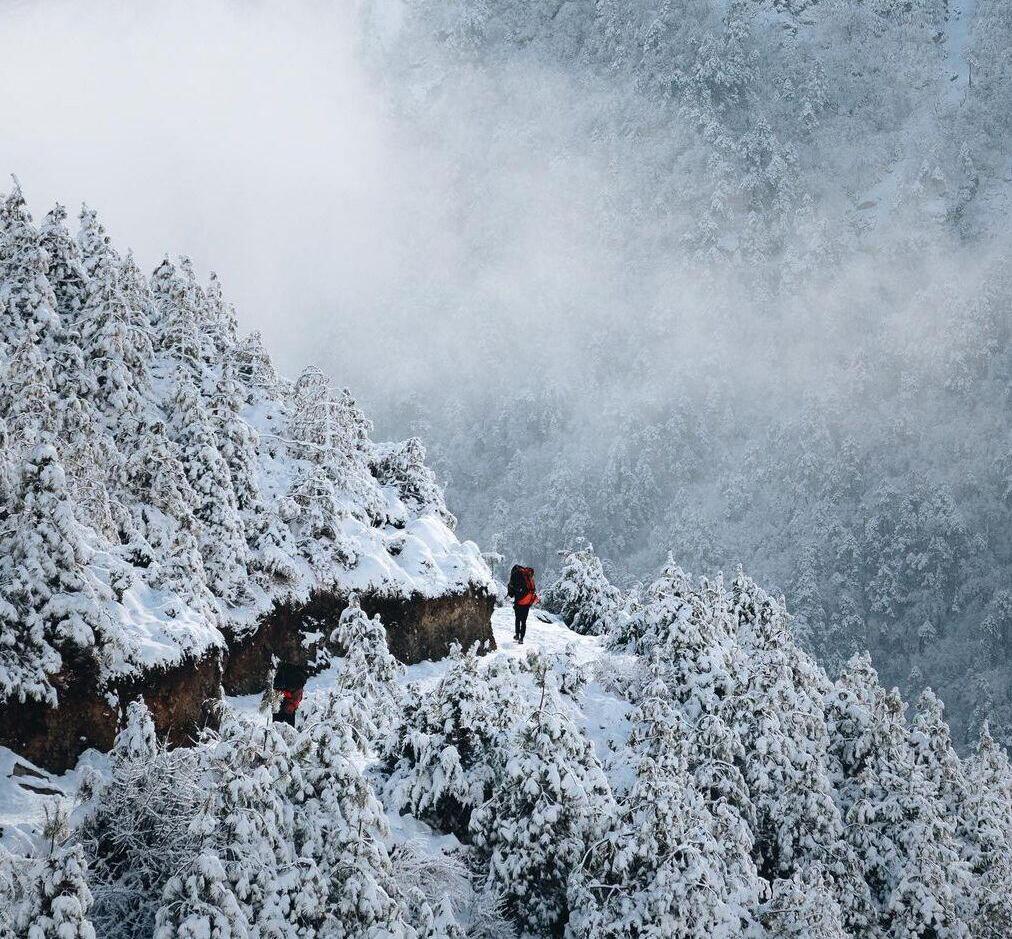
The trek through the Khumbu region constantly tests you in different ways:
Lower sections (Lukla to Namche): There is a seemingly endless succession of stone staircases to go either up or down. These can especially bring your knees and quadriceps to the limit. The continuous up-and-down is what most of those who have prepared for the trek only mentally and thought it was a steady upward climb find surprising.
Middle sections (Namche to Dingboche): By the time you reach this section of the trail the trees are nil and the air is very thin. The paths on which you will be walking run through forested mountains with very steep sides which drop sharply down to the valleys. Here you can also find high suspension bridges spanning over glacial rivers which you will need to cross one after the other and climbing rocky hiking trails that continue to get harder will be the only way for you to reach higher land.
Higher sections (Dingboche to EBC): The environment changes to that of a high-altitude desert as one continues upwards in the mountains. More mound of loose stones left behind Hobbling through the remains of the glacier-call valleys is what dominate the view. The air is so thin and every step thus so heavy that what would have been an easy walk if done at sea level has genuinely become challenging.
The mountain weather is very volatile and adds a new factor of difficulty to the thing. Even during the best seasons (March-May and September-November), it is recommended to be prepared for:
- Very low freezing temperatures in the morning at high altitudes
- Winds in the afternoon that can be both strong and cold
- Possibility of snow that can make the trails harder
- Fast weather changes that make it necessary to adapt quickly
When to Trek: Seasonal Difficulty Variations
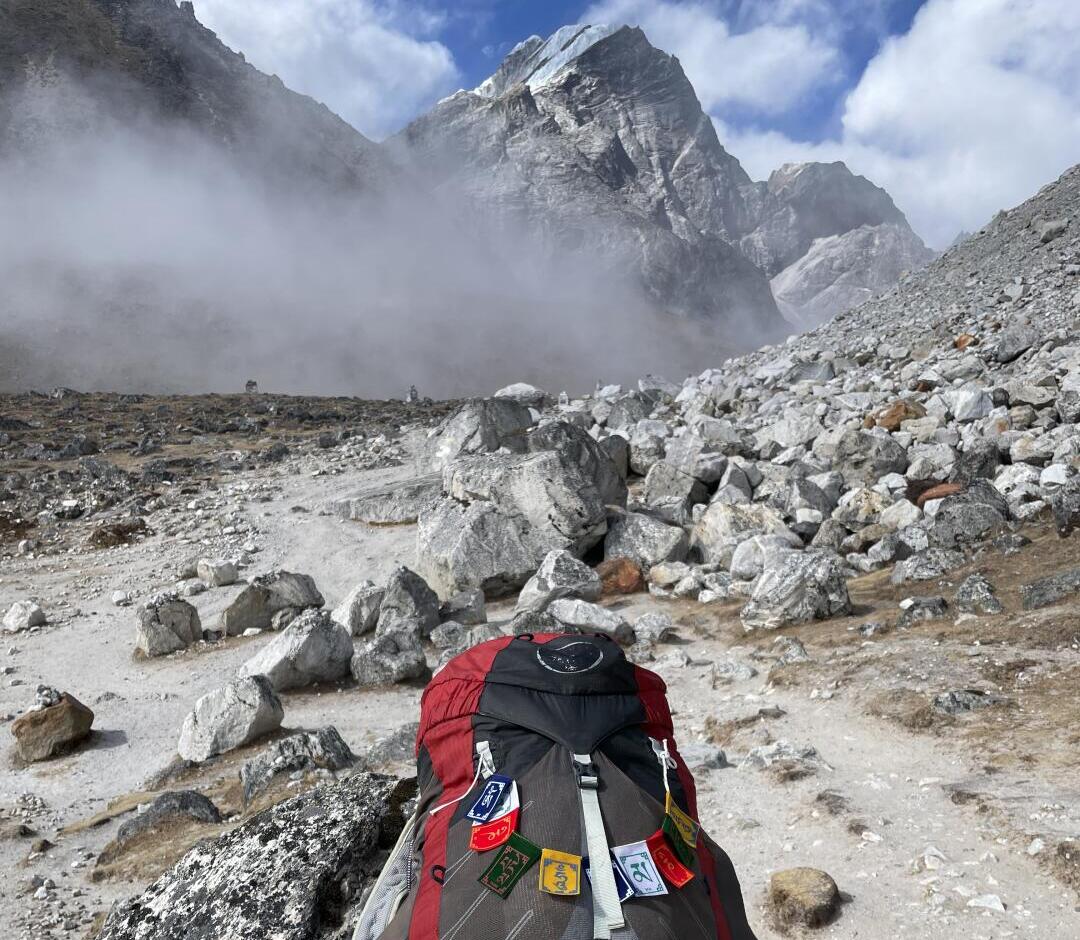
When you decide to go trekking is extremely crucial in determining the kind of experience you will have. Below is a detailed analysis of each month that would assist you in making a decision:
Best Time to Trek EBC - Monthly Comparison
| Month |
Avg Temp (Day/Night) |
Weather Conditions | Trail Conditions | Crowd Level | Visibility | Overall Difficulty | Recommendation |
| January | 4°C / -15°C | Cold, clear, dry | Icy, some tea houses closed | Very Low | Excellent | Very Hard ❄️❄️❄️ | Experienced only |
| February | 4°C / -15°C | Cold, clear, dry | Icy at altitude | Low | Excellent | Hard ❄️❄️ | Experienced only |
| March | 4°C / -15°C | Warming, occasional snow | Improving | Moderate | Very Good | Moderate 🌤️ | ✅ Good choice |
| April | 4°C / -15°C | Warm, stable | Excellent | High | Good | Moderate 🌤️ | ✅ Best season |
| May | 15°C / -2°C | Warm, pre-monsoon clouds | Excellent | High | Fair | Moderate 🌤️ | ✅ Good choice |
| June | 18°C / 2°C | Monsoon begins, cloudy | Wet, leeches below 3,000m | Very Low | Poor |
Hard 🌧️🌧️ |
Not recommended |
| July | 20°C / 5°C | Heavy rain, clouds | Muddy, landslide risk | Very Low | Very Poor |
Hard 🌧️🌧️ |
Not recommended |
| August | 19°C / 4°C | Rain continues | Wet, slippery | Very Low | Poor |
Hard 🌧️ |
Not recommended |
| September | 16°C / 0°C | Post-monsoon, clearing | Improving | Moderate | Good | Moderate 🌤️ | ✅ Good choice |
| October | 12°C / -5°C | Clear, stable, perfect | Excellent | Very High | Excellent | Moderate 🌤️ | ✅ Best season |
| November | 8°C / -10°C | Clear, cold, dry | Good | High | Excellent | Moderate-Hard ❄️ | ✅ Good choice |
| December | 5°C / -13°C | Very cold, clear | Icy, some closures | Low | Excellent | Hard ❄️❄️ | Experienced only |
Summary of the most important points:
- The winter period (Dec-Feb) is characterized by very good visibility but the very low temperatures make the trek a lot more difficult.
- The monsoon season (Jun-Aug) is a tough time for trekking and it is better not to go during that period.
- During the spring season (Mar-May) the rhododendrons come into bloom and the weather gets warmer.
- In the fall (Sep-Nov) the weather is the most stable and the views are the bestIf you want to avoid the crowd then trekking in March or at the end of November would be the best choice
Mental Toughness: The Underestimated Challenge
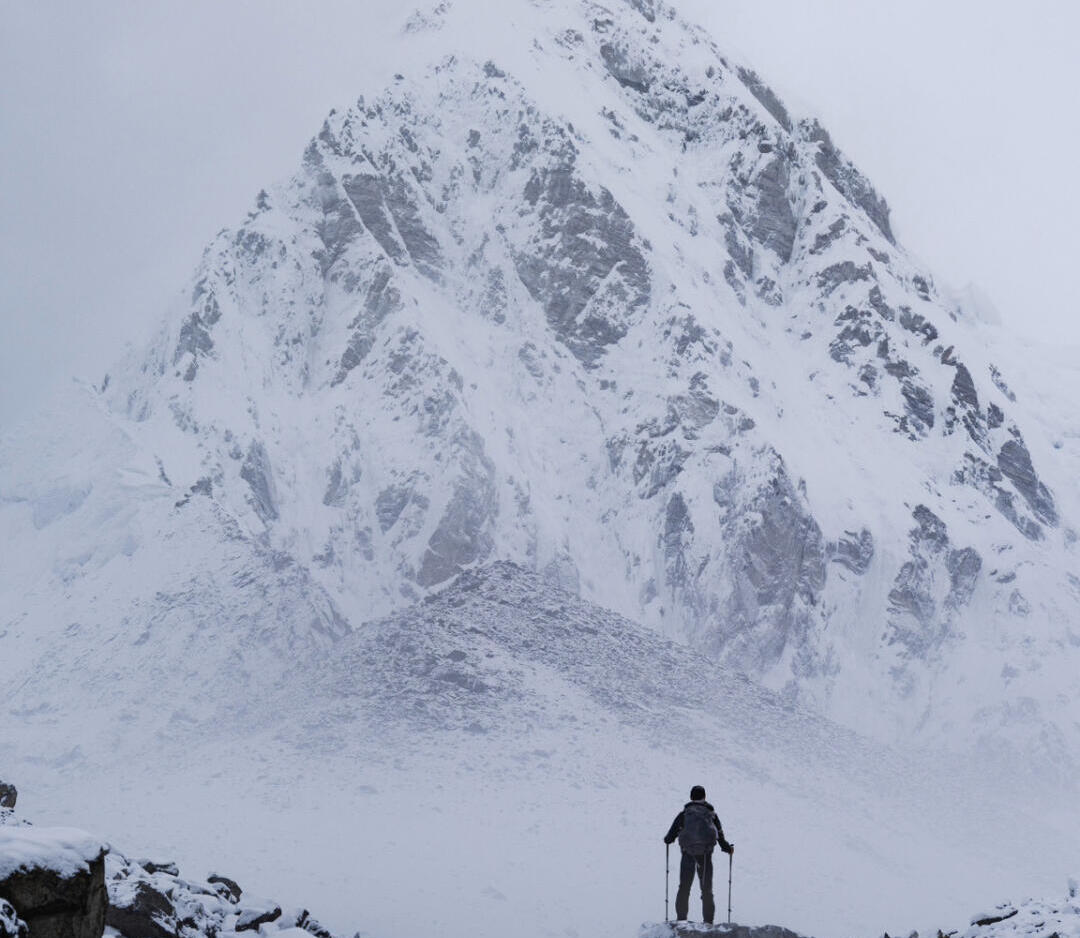
One experienced trekking veteran after another will argue that the mental aspect is more difficult than the physical one, and they are not far from the truth.
Coping with Discomfort
You will be living outside your normal space for two weeks. The tea houses, although nice and sufficient, are not five-star hotels. Bathroom facilities will be shared, sleeping unheated rooms where your water bottle might freeze at night, and eating monotonous meals will be your routine. The higher you go, the more basic the facilities will be. The continuous physical work, which is also affected by the altitude and simple accommodations, will wear you out and this will be a test-of-will type of challenge. There will be times, for example during a hard climb to Tengboche or a long day to Base Camp, when you will be wondering what the point of it all is.
Staying Motivated
The mental attitude often determines whether the EBC trek will be a success or not. One of the things that helps is:
- Breaking the trek into small goals: Do not contemplate reaching Base Camp when you are in Namche. Concentrate only on getting to the next teahouse, the next ridge, or the next village.
- Connecting with your reason: Remind yourself why you came. If it is for personal achievement, to honour someone, or to fulfil a dream, always keep that "why" with you.
- Finding delight in the journey: The mountains are breathtaking, the Sherpa culture is intriguing, and the feeling of the flock among trekkers is true. These moments of beauty and connection are what keep you up during the hard parts.
The Kala Patthar Challenge: The Trek's Hardest Day

While the trek culminates at Everest Base Camp, it is the ascent to Kala Patthar (5,545m) before dawn that is reckoned to be the most arduous part of the entire trek by most people. About 4 AM you will be roused from sleep, still feeling the exhaustion of the previous day's walk to Base Camp, and start the ascent in total darkness with only the light from the headlamps. Breathing is difficult due to the lack of oxygen at high altitude, and the biting cold of the night can even be felt through the best of protective clothing. Making every step is still very much in your conscious power. And yet to stand on the summit of Kala Patthar when the sun is lighting up Mount Everest is what most people would single out as the most rewarding moment of the whole trek. The view of Everest, Nuptse, Pumori, and the rest of the mighty Himalayan range from all around is what makes the hard trek worthwhile in the end.
Who Can Actually Do This Trek?
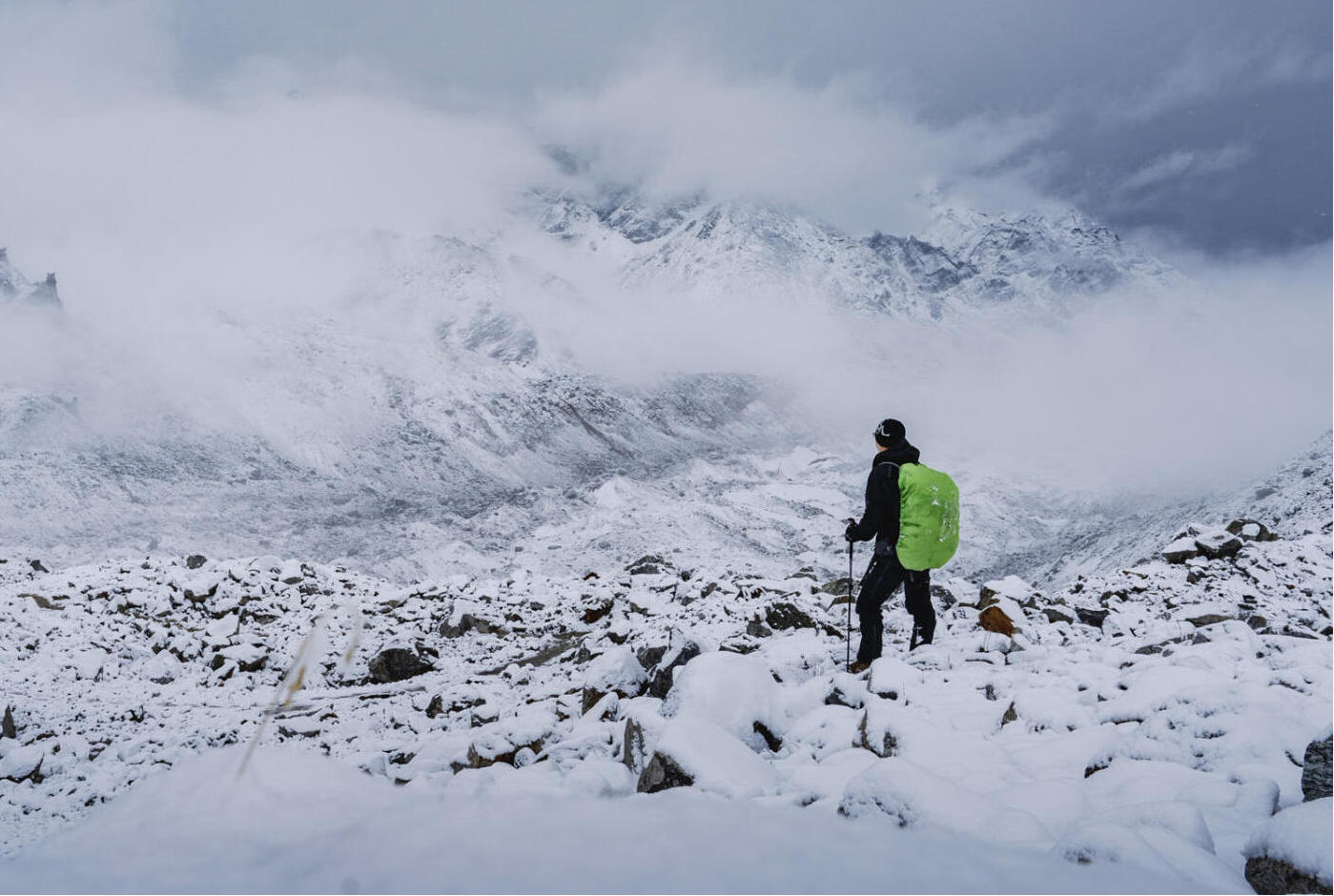
Here is some more comforting news: the Everest Base Camp trek is within the reach of a reasonably fit person (you don't need to be an elite athlete) but yes, you still must be quite realistic about the preparation and training that are needed.
Fitness Requirements
Good enough basics of fitness will be necessary. EBC should only be attempted when you are able to:
- Walk for 5-6 hours carrying a light pack without wearing yourself out too much
- Ascend a hill with relatively good ease
- Get back to your normal state of energy after physical exertion, quite quickly
Typically, people who succeed in EBC take at least 6-8 weeks of preparation before they depart. Their training regimen should consist of the following:
- Hiking on a regular basis while gradually increasing both distance and height of the trail
- One or more of the following: running, cycling, or swimming to improve cardiovascular fitness
- Leg-strengthening exercises with special emphasis on quadriceps and calves
- Core muscles strengthening to be able to carry a pack for long days
Age Considerations
Age is not a factor that discriminates. Escape Himalayahas made it possible for teens as well as people in their 60s and 70s to trek to Base Camp. The state's body, the mind's will and being well-prepared weigh much more than the number of years you have.
However, in a case when you are above 60 years of age or have any kind of condition, a check-up is advisable before making a reservation. Some mountaineers take longer routes with more acclimatization days, thus greatly increasing the success rate for all age groups.
Success Factors: What Makes the Difference

Proper Acclimatization
The importance of this cannot be emphasized enough. Travel plans that omit acclimatization days or ascend quickly without giving the body time to adapt, significantly raise the risk and the difficulty of the situation. The difference between a risky to a challenging but doable experience is made by a properly paced trek with enough rest days.
Experienced Guides
Knowledgeable guides do not only lead you along the route. They also check your health, detect the very first symptoms of acute mountain sickness, change the speed according to the weather and help you when your willpower is weak. Their knowledge of the trek challenges is like the difference of success or having to turn back.
The Right Gear
Good equipment plays a major role. Insufficient sleeping bags, bad boots, or a lack of things to wear in layers will make a difficult hike even more difficult. Buy reliable gear, and make sure everything is working before you leave.
Realistic Expectations
The most important success factor, perhaps, is to be fully aware of the trek when you set out. You should know it will be hard. Expect some discomfort. Acknowledge that there will be days when you will face challenges. If you're psychologically ready to face hardships, then they will be manageable instead of being too much for you.
Comparing EBC to Other Major Treks
Comparing EBC to the other options, are you curious how it really is? A comparative analysis like this one will help you figure out the position of EBC in the scale of Himalayan adventures:
| Trek Name | Max Altitude | Duration | Total Distance | Technical Difficulty | Altitude Challenge | Accommodation | Best Season | Ideal For |
|---|---|---|---|---|---|---|---|---|
| Everest Base Camp | 5,545m (Kala Patthar) | 12-14 days | 130 km | None required | Very High | Tea houses, good facilities | Mar-MaySep-Nov | First-time high-altitude trekkers with good fitness |
| Annapurna Base Camp | 4,130m | 7-11 days | 110 km | None required | Moderate | Tea houses, excellent | Mar-MaySep-Nov | Those wanting shorter Himalayan experience |
| Annapurna Circuit | 5,416m (Thorong La) | 15-20 days | 160-230 km | None required | Very High | Tea houses & lodges | Mar-MayOct-Nov | Cultural diversity seekers, experienced trekkers |
| Manaslu Circuit | 5,106m (Larkya La) | 14-18 days | 177 km | None required | High | Basic tea houses, camping | Mar-MaySep-Nov | Those seeking remote, less-crowded trails |
| Langtang Valley | 4,984m (Tserko Ri) | 7-10 days | 65 km | None required | Moderate-High | Tea houses | Mar-MaySep-Nov | First Himalayan trek, time-limited travelers |
| Upper Mustang | 3,840m | 10-12 days | 170 km | None required | Low-Moderate | Tea houses & lodges | Mar-Nov (rain shadow) | Cultural enthusiasts, desert mountain lovers |
| Three Passes Trek | 5,545m | 18-21 days | 160 km | Basic scrambling | Extreme | Tea houses, camping | MayOct | Experienced trekkers seeking ultimate challenge |
Everest Base Camp trek compared with few other popular Himalayan treks for understanding the difference in the difficulty levels:
Annapurna Base Camp: A little less challenging than EBC most of the time since it has a lower maximum altitude (4,130m) and is of shorter duration. If you want to have the Himalayan trekking experience but are worried about the altitude, this is a good option.
Annapurna Circuit: Has more changes in terrain and cultural experiences. The Thorong La Pass at 5,416m makes the trek as difficult as EBC. Overall, it takes a bit more time.
Manaslu Circuit: More difficult as it is farther from the rest of the world and has less-developed infrastructure, although the altitudes are about the same. Those who have already done EBC or a similar trek would be a better fit here.
Langtang Valley: A very good trekking trail to get yourself introduced with the Himalayas. The heights are low, and it takes fewer days but still, there are stunning mountain views.
Seasonal Variations in Difficulty
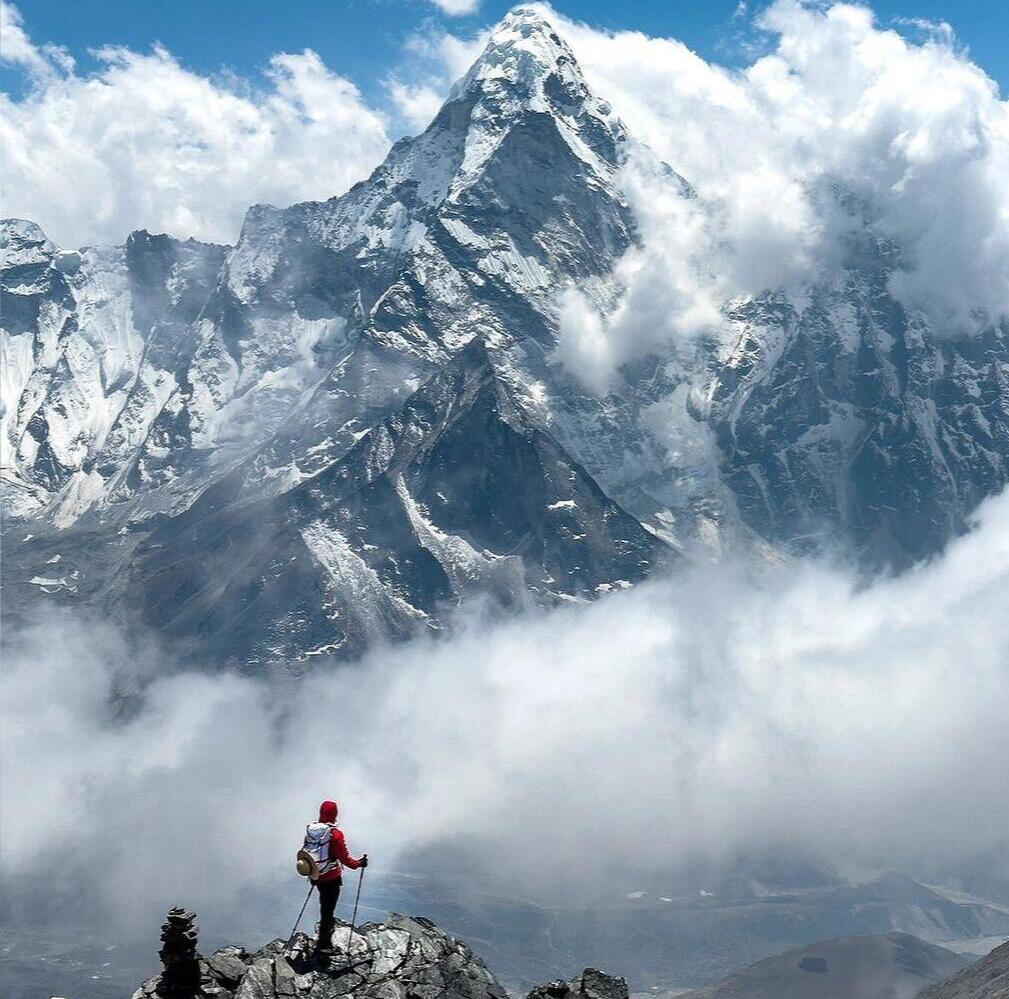
The difficulty level is heavily influenced by the seasons.
Spring (March-May)
The best season for EBC trekking is usually considered to be spring. Weather is more stable, temperatures are moderate, and trails are well-established. On the other hand, it is peak season, so expect more trekkers on the trail and tea houses more crowded.
Autumn (September-November)
It is also a great season with the same positives as well: clear and fresh skies, good temperatures, and great visibility. The freshness after the monsoon makes mountain views even more spectacular. As in spring, this is a peak season.
Winter (December-February)
Much more difficult because of the extreme cold, particularly, the uppermost part of the Himalayas. Most tea houses and lodges at higher altitudes have closed. It is only for adventurous and experienced trekkers with the necessary cold-weather clothing and who can handle the harsh conditions with a positive attitude.
Monsoon (June-August)
The season with the most challenges is that of the monsoon due to rain, clouds, and leech at lower elevations and limited views of the mountains. Troubled by landslides that may block the trail and hinder access to parts of the route. Generally, it is not recommended unless you want the solitude and don't mind the hard conditions.
Making Your Decision: Is This Trek Right for You?
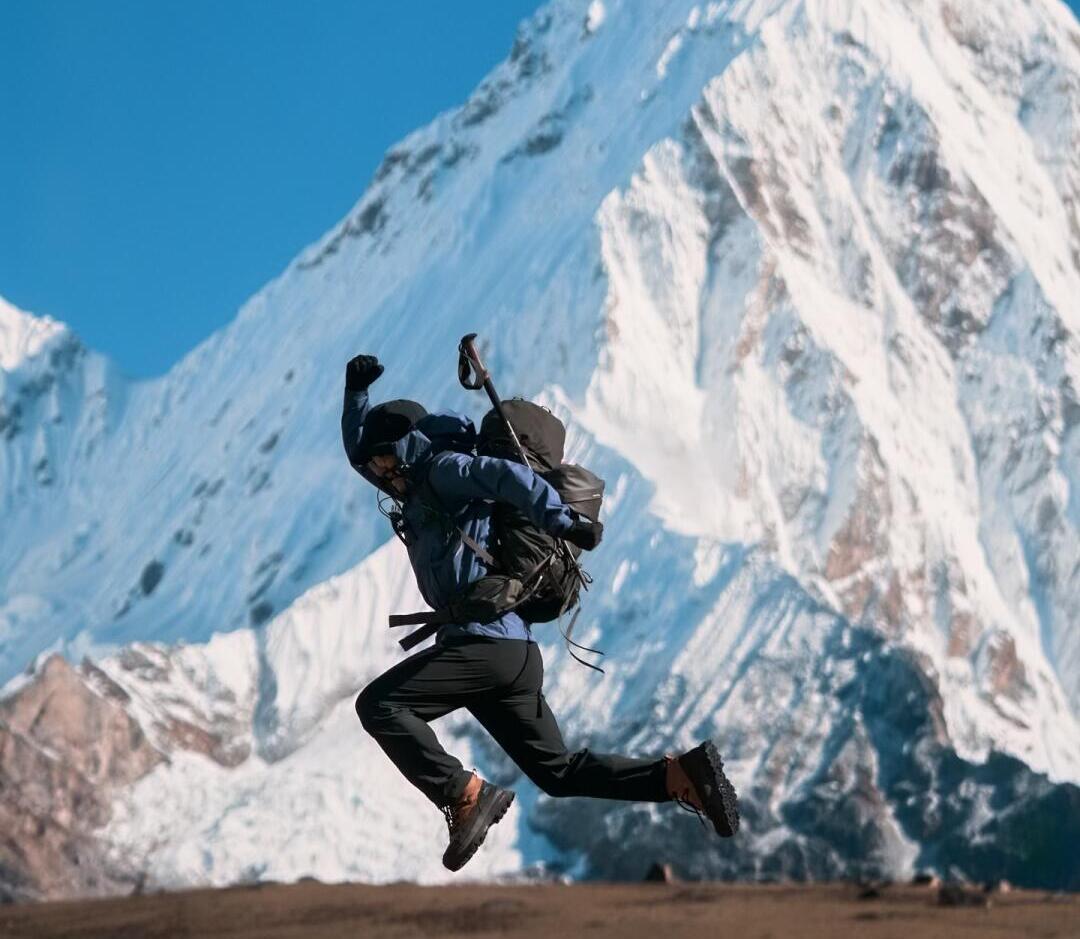
In the end, the decision to go for the Everest Base Camp trek is mainly based on a thorough self-check and being well-prepared.
Probably, you are prepared if:
- You promise yourself a thorough physical training before the trek
- You are mentally ready to face discomfort and challenge
- You know and accept the risks caused by the altitude
- You agree to follow the advice of the guides and change plans if necessary
- You can keep your spirits up when things go wrong
It would be better to think twice, if:
- You have health problems greatly and they are not confirmed as safe by a doctor
- You cannot find time for the training before the trek
- You are fantasizing about a comfortable and easy journey
- You are not willing to follow the acclimatization process
Final Thoughts: The Reward Beyond the Difficulty
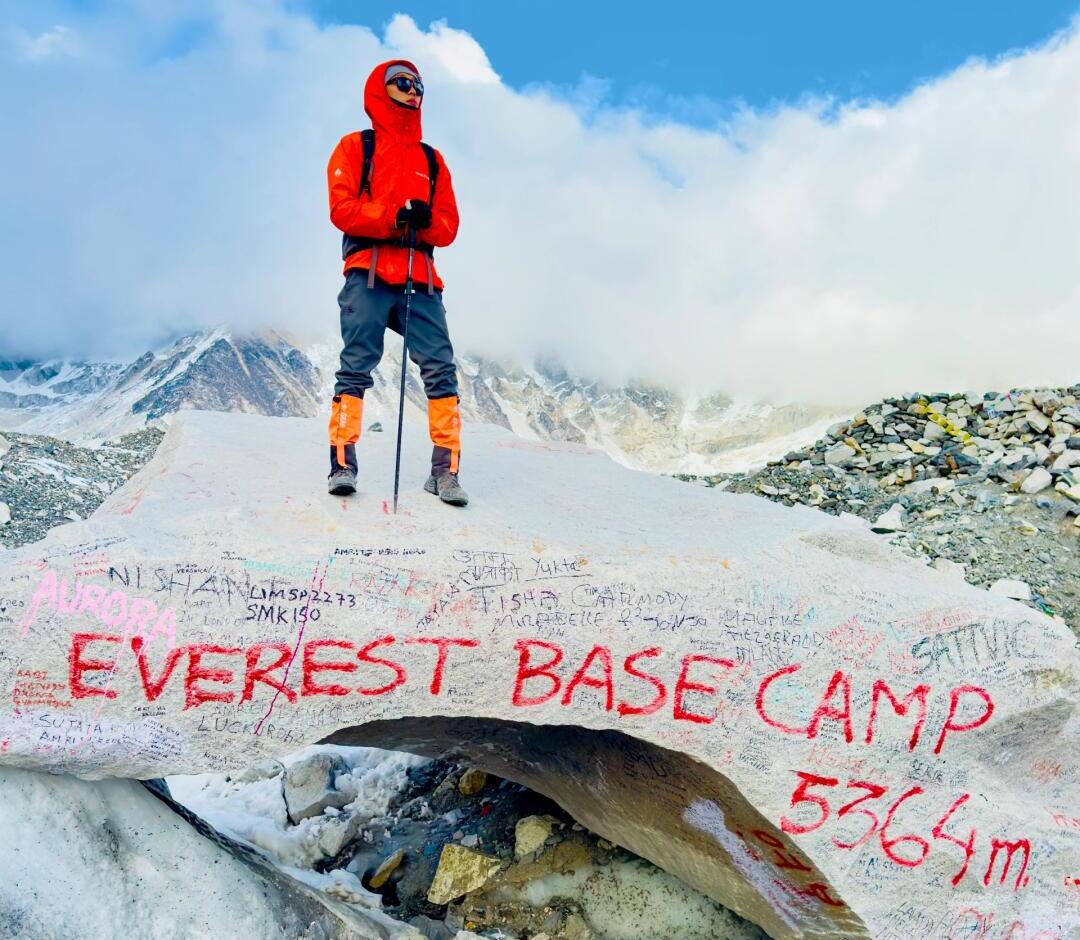
The trek to Everest Base Camp is undoubtedly hard. It will wear you out both in terms of body and mind. I am sure there will be times when you will ask yourself if you can go on.
However, this is what every single successful trekker will convey to you: the difficulty is what makes it the most valuable. It really inspires a feeling of accomplishment which is basically absent from the world of easy journeys, to be able to say that you stand at the foot of Mount Everest after having trekked for almost two weeks through the stunning mountain landscape of the planet.
The difficulty changes you. You will find themselves with the strength hidden deep inside your soul that you were previously unaware of. You will be making friendship bonds that will be firm because they will be formed through the sharing of hardship. You will be seeing things in a new way, which will be a direct result of going beyond your usual limits.
The Sherpa people, who live in the shadow of the Himalayas, have a saying which means exactly this: "Mountains have a way of dealing with overconfidence." Tackle this trek with reverence, be ready in the right way, and take up the challenge. The moment when you will be at Everest Base Camp, it will be clear to you that every hard step of the journey led you there.
The question is not whether the trek is difficult, it certainly is. The question is whether the reward is worth the challenge. The response is a definite yes for thousands of trekkers who are taking this journey every year.
About Escape Himalaya

For almost ten years, Escape Himalaya has been the leader of the greatest treks to the Base Camp of Mt. Everest. Your success is supported by our skilled guides, the safe practice of acclimatization, and the full range of the support services. We know the difficulties of such a trek by heart and therefore, our schedule is arranged in a way that you get the best experience from it. Do you have what it takes? Sounds like the path to the summit of the highest point on Earth is paved with just one initial step, and with that step, you have our guidance.
Contact us today to start planning your Everest Base Camp Adventure.




